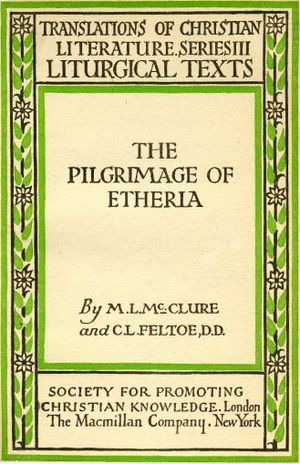Egeria (pilgrim) facts for kids
Egeria, also known as Etheria or Ætheria, was a Christian woman from Western Europe. She is famous for writing a detailed account of her long journey. She traveled to the Holy Land between about 381 and 386 AD. Her long letter, often called Peregrinatio or Itinerarium Egeriae, was written for a group of women back home. This travel diary is very important because it's one of the earliest of its kind. Parts of her original writing are now missing.
Contents
Finding Egeria's Story
The middle part of Egeria's travel diary survived. It was copied into a book called the Codex Aretinus in the 11th century. The beginning and end of her story were lost. In 1884, an Italian scholar named Gian Francesco Gamurrini found this old book. He discovered it in a library at a monastery in Arezzo, Italy. Later, in 2005, two new small pieces of her writing were found.
Who Was Egeria?
When Gamurrini first published the text, he thought the author was Saint Sylvia of Aquitaine. But in 1903, a scholar named Marius Férotin suggested the author was Aetheria or Egeria. He found this name in a letter written by a monk from the 7th century named Valerio of Bierzo. Férotin believed Egeria made her pilgrimage around 381–384 AD. This was during the time of Emperor Theodosius I.
Some scholars disagreed about when she traveled and where she was from. Some thought she was from Gallaecia (modern-day Spain). Others believed her language showed she might have been from Gallia Narbonensis (modern-day France). Most experts today agree that her journey happened in the 4th century.
Egeria's Life and Journey
Valerio's letter gives us some information about Egeria. He praised her and called her a nun. This might be because she addressed her travel account to her "sisters" (sorores) at home. However, during Egeria's time, it was common to call other Christians "sisters" and "brothers." So, she might have been writing to her Christian friends.
Egeria's ability to travel far and wide suggests she was from a wealthy family. Her journey was long and expensive. She also had many friends and helpful guides in the places she visited. Her education also shows she came from a good background. Valerio's letter mentioned she was from the "Western sea," which points to Roman Spain. However, Egeria also mentioned the Rhone river, which supports the idea of her being from Gaul (France).
Egeria's Amazing Travels
Egeria wrote down everything she saw and experienced in her letter. This letter is now known as Itinerarium Egeriae ("Travels of Egeria"). It is also sometimes called Peregrinatio Aetheriae ("Pilgrimage of Aetheria"). It is the earliest detailed account of a Christian pilgrimage that we still have today. Some parts of the text are missing.
Egeria likely wrote this story at the end of her journey. She used notes she took along the way. She wrote it for the women in her spiritual community back home. In the part of the text that survived, she describes her trip from Mount Sinai to Constantinople. She stayed in Jerusalem for three years. From there, she took trips to places like Mount Nebo and the tomb of Job.
What Egeria Saw
Egeria wrote a lot about the Holy Week celebrations and the Easter vigil in Jerusalem. She also visited the burial place of Haran, the brother of Abraham. She saw the spot where Eliezer met Rebecca. She spent time at the Sea of Galilee and wrote about the stories linked to it. These included the story of Christ feeding many people and where he performed miracles. On her way back to Europe, she stopped at the shrine of Saint Thecla near modern-day Silifke, Turkey. This saint was especially honored by women. After returning to Constantinople, she planned another trip to see St. John's shrine in Ephesus.
Church Practices and Language
The second part of Egeria's writing describes the church services and traditions in Jerusalem. This was likely under the guidance of Cyril. At the time of her visit, the church calendar was just starting to develop. Her account is very valuable because it shows how important Christian practices like Lent and Palm Sunday were becoming. She gives us a first-hand look at how these traditions were celebrated in the 4th century. Her writing also helps us understand that the celebration of the nativity of Jesus on December 25th was not yet universal.
Experts who study language have learned a lot from Egeria's letter. It shows how Latin was changing in ancient times into "Proto-Romance." This was the early form of languages like Spanish, Italian, and French. For example, she used phrases that show how words like "the" (definite articles) started to appear in these new languages. Her writing helps us see how languages evolve over time.
See also
 In Spanish: Egeria (viajera) para niños Chronological list of early Christian geographers and pilgrims to the Holy Land who wrote about their travels, and other related works
In Spanish: Egeria (viajera) para niños Chronological list of early Christian geographers and pilgrims to the Holy Land who wrote about their travels, and other related works
- Late Roman and Byzantine period
- Eusebius of Caesarea (260/65–339/40), Church historian and geographer of the Holy Land
- Anonymous "Pilgrim of Bordeaux", pilgrim to the Holy Land (333-4) who left travel descriptions
- St Jerome (Hieronymus; fl. 386–420), translator of the Bible, brought an important contribution to the topography of the Holy Land
- Madaba Map, mosaic map of the Holy Land from the second half of the 6th century
- Anonymous Pilgrim from Piacenza, pilgrim to the Holy Land (570s) who left travel descriptions
- Early Muslim period
- Paschal Chronicle, 7th-century Greek Christian chronicle of the world
- Arculf, pilgrim to the Holy Land (c. 680) who left a detailed narrative of his travels
- Medieval period
- John of Würzburg, pilgrim to the Holy Land (1160s) who left travel descriptions


